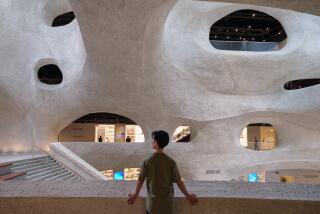More Than Barbarianism to ‘Nomads,’ Exhibit Shows
- Share via
Nomads of the Eurasian steppe, the mighty Genghis Khan and Attila the Hun among them, swept across the vast plain for 3,000 years, sparing no bloodshed as they conquered countless civilizations.
But there’s much more to these migratory peoples than barbarianism, with which they are so often identified.
“Nomads: Masters of the Eurasian Steppe,” an exhibition of about 1,300 artifacts opening today at the Natural History Museum of Los Angeles County, is likely to rectify this limiting stereotype.
Replete with skillfully carved sculptures, gold jewelry and delicate musical instruments--as well as daggers, swords and battle axes--the exhibit is designed to paint a full picture of a rich, influential culture whose lasting contributions include the popularization of pants, the saddle and the saber.
“The nomads didn’t just borrow from their sedentary neighbors, they created their own independent culture which could fit their way of life,” said exhibit curator Vladimir N. Basilov, a research expert from the Institute of Ethnography of the Academy of Sciences of the U.S.S.R. With the Natural History Museum, the academy co-organized the exhibit, another result of the 1986 Geneva superpower summit.
Basilov, who speaks fluent English, discussed the exhibit enthusiastically during last-minute preparations this week.
Spanning the era from the 8th Century BC to the early 20th Century, the show traces the lives of the Scythians and Sakians, the Huns, the Ancient Turks and the Mongols until agrarian ways largely replaced nomadic life, he said.
Constantly traversing the unbroken steppe (which extends 4,000 miles from the Black Sea to the Great Wall and from Northern Siberia to the Himalayas and the Gobi Desert), these sheepherders “followed their animals whenever they needed new pastures. So they had to have a comfortable dwelling--easy to transport--a comfortable costume and lightweight, unbreakable utensils and tools,” Basilov said.
Pointing out artifacts that exemplify the mobile life style, the curator ducked into a furnished yurt big enough for 30.
The yurt is the dome-shaped portable dwelling with a skeleton of curved wood poles bound together by cords. It can easily be disassembled in about two hours, and its flexible structure withstands the steppe’s violent windstorms, he said. “It doesn’t break, it just moves with the wind.”
Formidable horsemen, the nomads over time developed the rigid saddle and stirrups. As well as making prolonged travel more comfortable, the equipment enabled riders to keep a firm seat while shooting arrows or wielding a sword in full gallop. Basilov jokingly described a time-worn, 1,500-year-old saddle as “ugly pieces of wood.”
Trousers already existed, but since they were more comfortable on horseback than bare legs, the nomads made them “an element of everyday costume,” Basilov said. Looking at one pair big enough to fit two fat, full-grown men, he said it’s easy to see why Taras Bulba, the fictional Hun, was said to have worn trousers “as wide as the Black Sea.”
Other early nomadic innovations include the first bowed instruments, often used by shamans to summon spirits, and the saber. Grasping a visitor’s wrist, Basilov made a sharp slicing gesture to demonstrate the weapon’s efficiency in slashing human flesh.
Indeed, while they were music lovers and engaged in amiable trade relations, the Eurasian nomads constantly waged war on such civilizations as Greece, Rome and China, which built the Great Wall in its defense.
“For them, war was one of the branches of the economy,” he said, describing military raids that yielded gold and other lucrative goods.
The “Golden Man,” a dazzling reconstruction of a costume worn by a 5th-Century BC Sakian aristocrat, is a tribute to the nomads’ voracious appetite for the shiny metal. The costume, re-created with artificial materials, consists of a tunic and a tall, cone-shaped headdress covered with gold ornaments depicting snarling snow leopards and stylized elk, horses or deer. Many of the genuine ornaments also are on view.
The artifacts in “Nomads,” which also features colorful textiles and garments, domestic utensils, religious and ceremonial articles and armor, were culled from 10 Soviet institutions, including Leningrad’s famous Hermitage.
“All the ancient cultures were constantly influenced, in a friendly or military way, by the Eurasian nomads--Russia, China, Persia, Southern Asia, India, the ancient Greeks and Europe,” Basilov said. “We can’t understand the history of the Old World if we have no good information about the history of the nomads.”
“Nomads,” here through April 16, will travel to the Denver Museum of Natural History and Washington’s Smithsonian Institution. Reservations are required. Tickets are available at the museum in Exposition Park and from all TicketMaster outlets, the May Co. and Music Plus stores. Information: (213) 744-6292.
More to Read
Sign up for Essential California
The most important California stories and recommendations in your inbox every morning.
You may occasionally receive promotional content from the Los Angeles Times.










